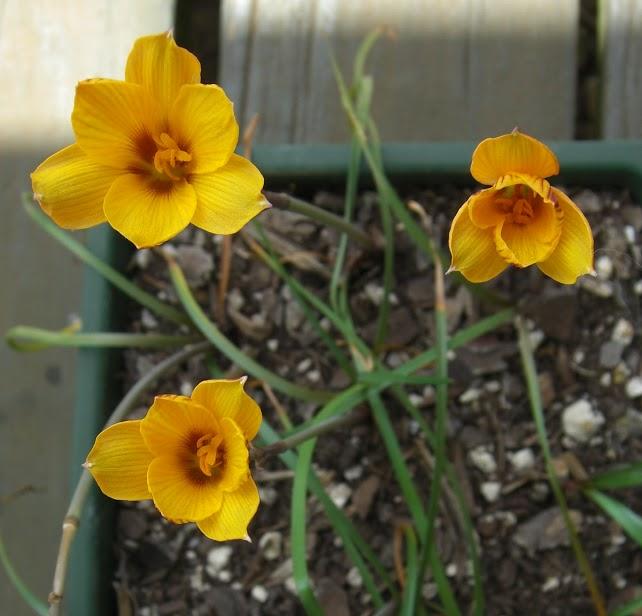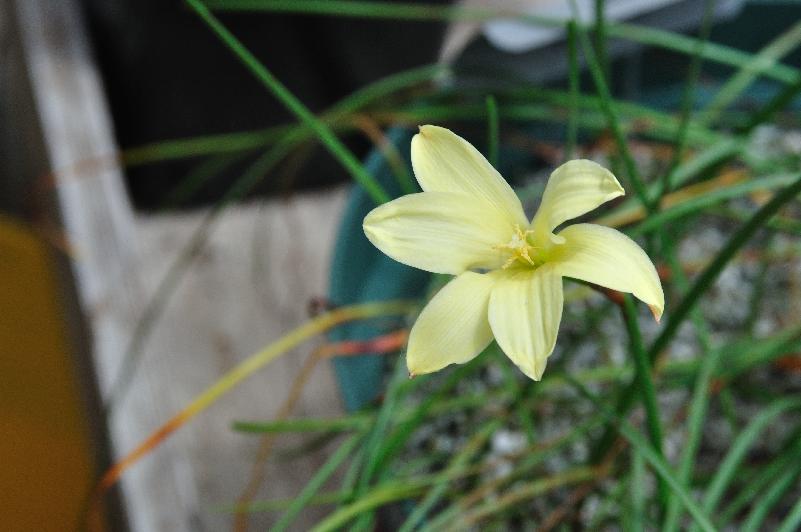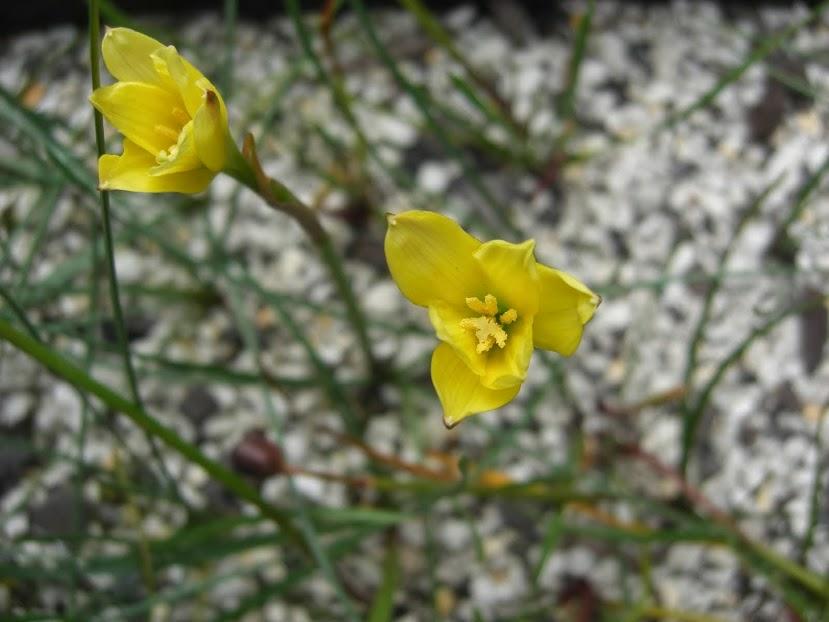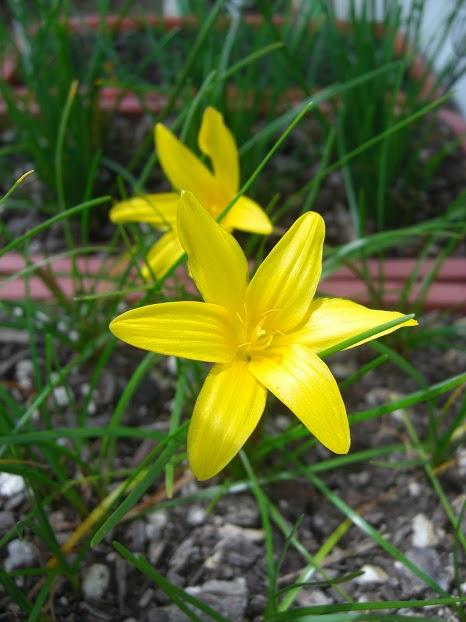Yellow Rain Lilies
Yellow flowered rain lilies occurring in the U.S.A.
There are several more-or-less yellow flowered rain lilies in the U.S.A. Besides Habranthus tubispathus, better known in the past as "Habranthus texanus," there is Habranthus longifolius (formerly known as Zepyranthes longifolia), the exotic Zephyranthes citrina, and the group of interesting and inter-related Texas plants: Zephyranthes pulchella, jonesii, refugiensis, and smallii.
Habranthus tubispathus is a very wide-ranged species, found from Texas to Argentina. There are numerous local forms of it in Brazil and Argentina. The plant is small as is the flower. The dull green leaves are about 4 mm wide, apearing after the flowers have opened. The golden yellow flower has red veins on the outside surfaces of the tepals. The basal portions of the outside of the tepals usually have the red, purple, or bronze coloring like the veins. Alberto Castello of Argentina has pointed out to me that the three lobes of the stigma distinguish this species from most other rain lilies. They are characteristized by a fringed appearance, having a unique "ostrich feather" or spirally twisted form, and they are not filiforn or cylindrical as in the other species. The key is their resembling a feather with a twist. For its chromosomes, 2n=24.
This species was probably brought to Texas from South America by the early Spanish but now seems to be naturalized. Thad Howard discussed the discontinuous ranges of this species and of Zephyranthes drummondii, both found in Texas and in Brazil and Argentina.

Copyright by Ina Crossley. Reproduced by permission.
Habranthus tubispathus
Habranthus longifolius used to be known as Zephyranthes longifolia. It is native to West Texas, southern New Mexico, southeastern Arizona, and adjoining parts of Mexico. The leaves are dull green and 1 to 2 mm wide. The light yellow flower is funnel shaped, with the tube green. The flower is held slightly inclined to erect. The stigma is trifid and usually at the level of the anthers. Chromosomes: 2n=24.
This species, like H. tubispathus, is yellow and has a trifid stigma. The flower of longifolius is uniformly light yellow, the stigma is not feathery, and the peduncle tends to be longer than that of tubispathus. This species differs from citrina in having the trifid stigma, while citrina has a capitate stigma. H. longifolius is not common in cultivation.

Habranthus longifolius
Zephyranthes citrina is thought to have originated in Central America, but it has been found in many parts of the world where rain lilies are definitely not native. The leaves are dull green and up to 4 mm wide. The flower is lemon yellow and funnel shaped. The stamens are of two distinctly different lengths. The tube is green and tapered, widening as it meets the tepals. The stigma is capitate and is usually at or just below the level of the anthers, and never more than 1 mm above them. Chromosomes: 2n=48. I don't have a picture of this species yet.
Zephyranthes pulchella is another small cadmium yellow flower. The stigma is capitate and held at about the same level as the anthers. The dull green leaves are up to 3 mm wide. This species is native to southern Texas and northeastern Mexico. 2n=48.
One distinguishes between this species and the following species by the relative lengths of their floral tubes (the basal portion of the perigone where the tepals are all fused into one tubular structure), the tepals themselves, and the filaments. At the moment I do not have a picture of Z. pulchella.
In pulchella, the floral tube is green and less than 1/4 the perianth length and only about half the length of the filaments. Rather than being purely cylindrical, the floral tube increases in diameter as it rises to meet the tepals.
Zephyranthes jonesii is the first of three species that are considered to have arisen from hybridization of Z. pulchella with Z. chlorosolen. It is found only in one small area in coastal Texas. The leaves are dull green, up to about 3 or 4 mm in width. The pale lemon yellow flower is salverform to funnelform. The tube is yellow with some green and longer than the spathe. The style is longer than the floral tube and the stigma is capitate. 2n=48, 72.
It is distinguished by having the perianth tube about 7 or more times the length of the filaments.

Copyright by Ina Crossley. Reproduced by permission.
Zephyranthes jonesii
Zephyranthes refugiensis is thought to be the result of a back cross of a hybrid parent (pulchella x chlorosolen) onto pulchella. The leaves are dull green, up to 4 mm wide. The funnel-shaped flower is held erect, and the color is a dark lemon yellow. The perianth tube is green. 2n=46, 48. We have no picture of Z. refugiensis. While jonesii and smallii are in many rain lily collections, refugiensis seems to be much rarer in cultivation.
Zephyranthes smallii, the third species resulting from a natural hybridization, occurs only in and around Brownsville, Texas. It is thought to have become extinct in the wild, since the region where it occurs has undergone major commercial development. Z. smallii is also thought to be from a hybrid between pulchella and chlorosolen. 2n=53, 54, 58, 70, 72.
The leaves are 5 mm wide. The lemon yellow flower is held erect. The cylindrical perianth tube is shorter than the spathe and 3 to 5 times as long as the filaments. The stigma is capitate.

Copyright by Ina Crossley. Reproduced by permission.
Zephyranthes smallii from Ina Crossley
When we start to consider the rain lilies from outside the U.S.A., the number of species explodes. There are approxiamtely 175 know species of Habranthus and Zephyranthes, and many of them are rare and not well known even to botanists. The coverage will therefore be limited to species that are in cultivation (at least by serious bulb collectors) and about which at least something is known.
Good sources for information on rain lilies, which I have drawn heavily upon, are these:
- R. Flagg, G. Smith, and W. Flory, "Flora of North America," vol. 26, pp. 281-282 and 296-303 (2002).
- Scott Ogden, "Garden Bulbs for the South," Taylor Publishing Co., Dallas, Texas (1994).
- T. M. Howard, "Bulbs for Warm Climates," University of Texas Press (2001).
- Pacific Bulb Society's Images Wiki
Good gardening, from here in central Indiana
Jim
<shieldsgardens@gmail.com>
Look up technical terms in the Glossary of Plant Biology